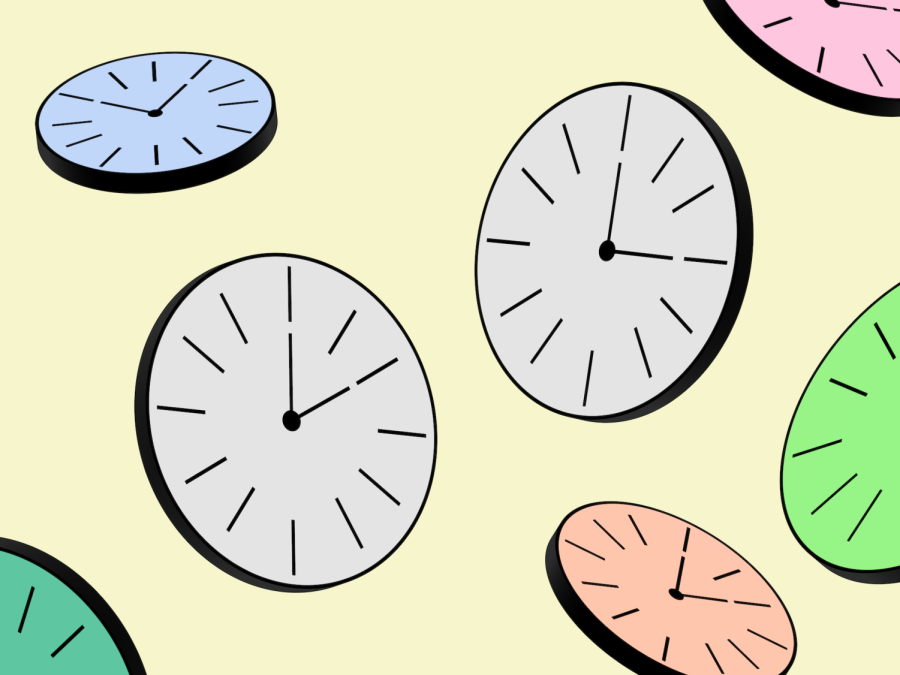Editorial: Make daylight saving time permanent
The Sunshine Protection Act would bring a much-needed end to the biannual clock switching, placing us permanently on daylight saving time.
The Sunshine Protection Act would make daylight savings time permanent. (Staff Illustration by Susan Behrends Valenzuela)
March 28, 2022
Two weeks ago, the U.S. Senate unanimously approved a bill to make daylight saving time permanent. Called the Sunshine Protection Act, the bill would put an end to the changing of our clocks every year in November and March. The United States would join Japan, India and China as one the few countries that do not observe a time change. Switching back and forth from daylight saving time is something that Americans have been upset about for a long time. And if our Senate can pass a bill unanimously, that’s certainly something to be said in favor of the idea.
Daylight saving time was designed so that darkness would come at a later time in the day during the warmer months, when days are longer. The idea originated in 1895, and in 1966 the United States passed the Uniform Time Act to establish a yearly time change. In the vast majority of the United States, clocks move forward an hour in March — this means that 10 a.m. in standard time, which is what we experience in the winter, becomes 11 a.m. in daylight saving time. In November, the clocks move back an hour, and 11 a.m. becomes 10 a.m. again.
The idea is there, but the logistics are confusing. Not every state observes a yearly time change. Arizona does not change their clocks, instead sticking to Mountain Standard Time year-round. Hawaii also does not observe the change.
Though over 70 countries observe some form of daylight savings, their time changes do not begin at the same time. The United States makes the switch on the second Sunday in March at 2 a.m., while Mexico does so on the first Sunday in April. Many European countries do so on the last Sunday in March at 1 a.m. Coordinated Universal Time. The logistics of arranging meetings across countries, consequently, become difficult to navigate. People traveling from one place to another have to piece together which time zone they’re in, as well as the time within that time zone. The biannual clock switch is badly executed and unnecessarily confusing — there’s no reason for us to keep it.
America seems somewhat split on how to end it. A 2021 YouGov poll found that 63% of adult Americans want to get rid of the yearly time switch, with 48% preferring permanent daylight saving time. Elderly people, however, did not seem to agree: 77% wanted to keep the time change, perhaps out of habit. The poll also showed that Democrats and Republicans shared fairly similar views on daylight saving time — 67% of each party wanted to bring an end to it.
Making daylight saving time rather than standard time permanent is the right move. We observe daylight saving time nine months out of the year, after all. For those nine months, we enjoy longer daylight hours.
One Brigham Young University study found in 2016 that students with more sunlight exposure during the day had less psychological distress. Time Magazine cited an Australian study, saying that “people had higher serotonin levels on bright sunny days than on cloudy ones.” More daylight means happier people.
It would be easy to tolerate the adjustment to the three months in which we currently observe standard time. Keeping daylight saving time in place during those months would allow for more daylight in the middle of the day, as opposed to just the morning. Yes, it might be a little darker when you’re getting ready for your 8 a.m., but you would enjoy more daylight throughout the day.
The Sunshine Protection Act must make it through the House before getting signed into law by President Biden; if it passes,it will be implemented in November 2023. The Senate’s unanimous vote bodes well for the House’s decision — it seems like everyone is tired of daylight savings.
Opinions expressed in the house editorial reflect the views of the Editorial Board, which is composed of the Opinion Editors, the Deputy Opinion Editors and the Editor-in-Chief. The house editorial does not necessarily represent the opinions of WSN or its staff.
Contact the Editorial Board at [email protected].
























































































































































